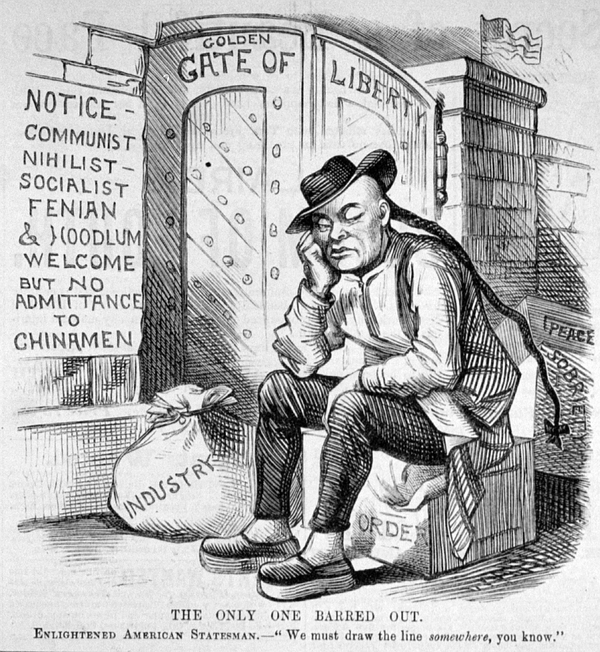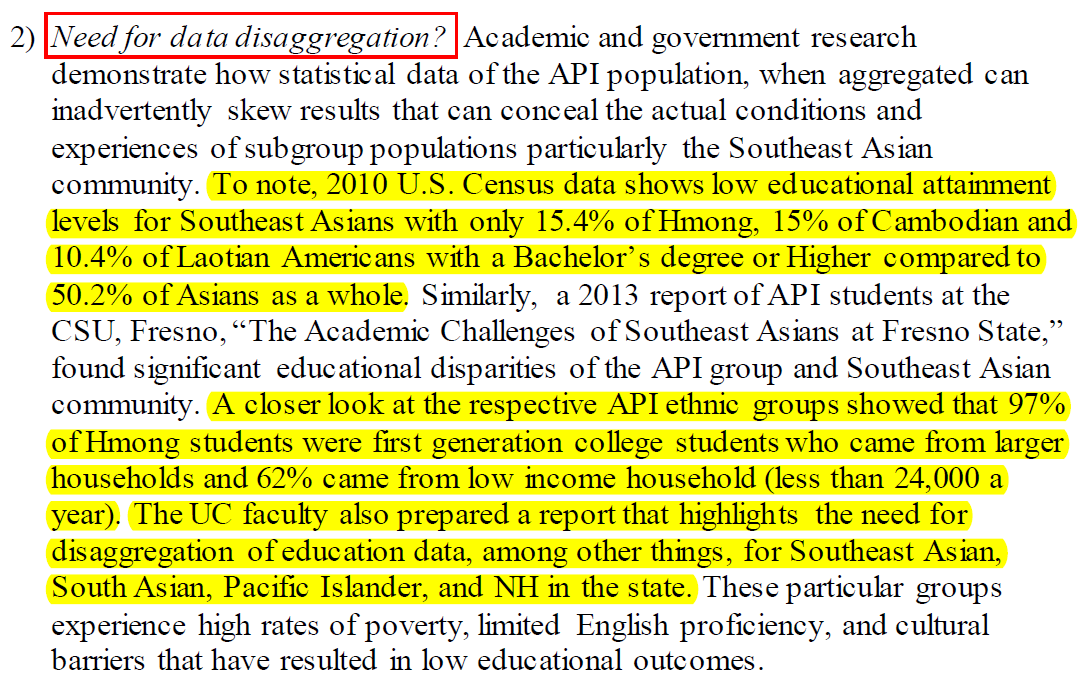AB 1726 µ│òµíêþÜäµ£¼Þ┤¿ÕÆîÕ»╣þ¡û(õ╣ïõ║î´╝ÜÕàÀõ¢ôþÉåÞºúAB 1726 µ│òµíê)
þÑØÕç▒-1377 03/26 16745
AB 1726 µ│òµíêþÜäµ£¼Þ┤¿ÕÆîÕ»╣þ¡û(õ╣ïõ║î´╝ÜÕàÀõ¢ôþÉåÞºúAB 1726 µ│òµíê)
þÑØÕç», SVCA (Silicon
Valley Chinese Association)
´╝êõ║î´╝ëÕàÀõ¢ôþÉåÞºúAB
1726 法案
2015 Õ╣┤ÕèáÕÀ×Þ««õ╝ÜÚÇÜÞ┐çõ║åAB
176 ÒÇéÕç║õ║║µäŵûÖþÜäµÿ»´╝îÕ░¢þ«íÞ┐Öõ©¬µ│òµíêÕ£¿ÕÅéõ╝ùõ©ñÚÖóõ©ìÕêåÕàܵ┤¥Õ£░Õçáõ╣Äõ©ÇÞç┤ÚÇÜÞ┐ç´╝îÕ©âµ£ùÕÀ×Úò┐Õ£¿2015Õ╣┤10µ£êÕɪÕå│õ║åAB 176 (http://www.gov.ca.gov/docs/AB_176_Veto_Message.pdf)ÒÇéÕ©âµ£ùÕÀ×Úò┐þÜäveto message ÚØ×Õ©©þÜäÚ½ÿþ×╗Þ┐£þ×®´╝îõ¢ôþÄ░õ║åõ©Çõ©¬þ£ƒµ¡úµö┐µ▓╗Õ«ÂþÜäµÖ║µàº´╝îÞÇîµêæõ╗¼õ╝Üþ¿ìÕÉÄÕàÀõ¢ôÕêåµ×ÉÒÇéAB
176þÜäÕçáõ©¬µ░æõ©╗ÕàܵĿµëïÞ««Õæÿ(Rob Bonta, þ¢ùÞ¥¥õ╝ª´╝îÚé▒õ┐íþªÅþ¡ë) Õøáõ©║ÚØ×Õ©©Õñ▒µ£ø´╝îÕÅæÕ©âõ║åþö▒õ©Çõ©¬ÕŽChinese for Affirmative Action (CAA) þÜäþ╗äþ╗çµëÇsponsorþÜäõ©Çõ©¬µû░Úù╗õ╝Ü (https://www.youtube.com/watch?v=cWR25HNUQMY)ÒÇéõ╝Üõ©è´╝îÕçáõ©¬Þ««ÕæÿÕÆî AB 176þÜäµö»µîüÞÇàµÿÄþí«µùáÞ»»Õ£░Þí¿Þ¥¥´╝îAB 176þÜäõ©Çõ©¬ÚçìÞªüþø«þÜäÕ░▒µÿ»Õ©«Õè®Úéúõ║øµëÇÞ░ôÕÉÄÞ┐øþÜäõ║ÜÕñ¬Þúöժ鵃¼ÕƒöÕ»¿Þúö´╝îÞÇüµîØÞúö´╝îÞïùÞúöþ¡ëÞÄÀÕÅûµø┤ÕñÜþÜäÕñºÕ¡ªÕ¡ªõ¢ìÒÇéÞ┐Öõ©¬µû░Úù╗õ╝Üõ©èþÜä
podium µèè CAA þÜäÕÉìÕ¡ùµîéÕ¥ùÕ╝éÕ©©þÜäÚåÆþø«ÒÇé
µø┤ÕèáÕç║õ║║µäŵûÖþÜäµÿ»´╝îÕ£¿Õ©âµ£ùÕÀ×Úò┐ÕɪÕå│õ║åAB
176ÕÉÄþƒ¡þƒ¡þÜäõ©ëõ©¬µ£êÕåà´╝îRob Bonta ÕÅêõ║Ä2016Õ╣┤1µ£êµÄ¿Õç║õ║å
AB 1726ÒÇéAB 1726 µÿ» 2015 AB 176 þÜäõ©Çõ©¬µö╣Õñ┤µìóÚØó´╝îõ¢åµìóµ▒ñõ©ìµìóÞì»´╝îÕ«×ÚÖàÕåàÕ«╣Õçáõ╣Äõ©Çµ¿íõ©ÇµáÀþÜäµû░þëêµ£¼ÒÇéÕ«âõ╗¼Ú⢵ÅÉÞ««õ┐«Þ«óÕèáÕÀ×þÜä
Government Code Sec. 8310ÒÇéµëÇõ╗ÑÞªüÕêåµ×É AB
1726´╝îµêæõ╗¼ÞªüÕàêþÉåÞºú Gov. Code ┬º 8310 ÕÆîÕ«âþÜäþ½ïµ│òÕÄåÕÅ▓ÒÇéÞÇîþÉåÞºúÞ┐Öõ©Çþé╣´╝îµêæõ╗¼Õ¥ùõ║åÞºúþ¥ÄÕø¢õ║║ÕÅúµÖ«µƒÑþ╗ƒÞ«íþÜäÕÄåÕÅ▓´╝îÕÆîõ©Çõ║øÕìÄõ║║õ║ÜÞúöÕ£¿þ¥ÄÕø¢þÜäÚöÖþ╗╝ÕñìµØéþÜäµö┐µ▓╗µ│òÕ¥ïþ║áþ╗ôÕÅ▓ÒÇé
µÄÆÕìĵ│òµíê´╝îõ║║ÕÅúµÖ«µƒÑµùÅÞúöÕêåþ▒╗´╝îÕÆîÕèáÕÀ×µ£ëÕà│þ½ïµ│ò
þ¥ÄÕø¢þÜäõ║║ÕÅúµÖ«µƒÑþ╗ƒÞ«íõ╗Ä1790Õ╣┤Õ░▒Õ╝ÇÕºïõ║å´╝îµ»ÅÕìüÕ╣┤õ©Çµ¼íÒÇéµêæõ╗¼Õ¥êÕñÜõ║║Þ«░Õ¥ùµØÑþ¥ÄÕø¢Þ»╗õ╣ªþö│Þ»ÀÕ¡ªµáíµù´╝îÕ£¿þö│Þ»ÀÞí¿õ©èµ£ëõ©ÇµáÅÕí½ÕåÖÞç¬ÕÀ▒µùÅÞúöþÜäÚÇëÚí╣ÒÇéÞÇîµ£ëÕ¡ÉÕÑ│Þªüþö│Þ»ÀÕ¡ªµáíþÜäþêµ»ì´╝îõ╣ƒõ╝ÜÕÉîµáÀÞ«░Õ¥ùÒÇéþ╗åÕ┐âþÜäõ║║õ╝ܵâ│ÞÁÀ´╝îÞ┐Öõ©¬ÚÇëÚí╣ÚçîÕ»╣õ║ÜÞúöµ£ëµ»öÞ¥âþ╗åþÜäÕêåþ▒╗´╝îµ»öÕªéõ©¡Õø¢õ║║´╝îµùѵ£¼õ║║´╝îÕì░Õ║ªõ║║þ¡ëþ¡ë´╝îõ¢åÕê½þÜäÕñºõ║║þºìµ»öÕªéþÖ¢õ║║µêûÚ╗æõ║║Ú⢵▓íµ£ëÞ┐Öõ╣êþ╗åþÜäÕêåþ▒╗ÒÇéõ©║õ╗Çõ╣êõ╝ÜÞ┐ÖµáÀ´╝ƒÕàêµØÑþ£ïõ©Çõ©¬ÕÄåÕÅ▓Þ«░õ║ïÞí¿´╝Ü
┬À 1850Õ╣┤ÕÀªÕÅ│´╝îõ╝┤ÚÜÅþØÇÕèáÕÀ×µÀÿÚçæþâ¡´╝îÕÅ▓õ©èÕç║þÄ░þ¼¼õ©Çµ¼íÕñºÞºäµ¿íÕìÄõ║║þº╗µ░æþ¥ÄÕø¢µ¢« (http://tinyurl.com/loc-chinese)
ÒÇé
┬À 1863-1869Õ╣┤´╝îÕìÄõ║║þº╗µ░æÕ£¿Õ¥«ÞûäÞû¬ÞÁäÕÆîµ×üÕàµüÂÕèúþÜäÕÀÑõ¢£µØíõ╗Âõ©ï´╝îõ╗ÿÕç║þ║ªõ©ñÕìâµØíþöƒÕ梴╝îõ©║õ┐«þ¡æµ¿¬Þ┤»þ¥ÄÕø¢õ©¡ÞÑ┐Úâ¿þÜäÕñ¬Õ╣│µ┤ïÚôüÞÀ»ÕüÜÕç║õ║åÕÀ¿ÕñºÞ┤íþî«´╝êÞÖ¢þäÂÕ«óÞºéþÜäÞ»┤´╝îÞ┐ÖþºìÞ┤íþî«õ©ìµÿ»Þ笵ä┐þÜä´╝îÞÇîµÿ»Õ£¿Õè│ÕÀÑÕ©éÕ£║õ©¡þÜäõ©ÇþºìµùáÕÑêþöÜÞç│µé▓ÕôÇþÜäÚÇëµï®´╝ëÒÇéÕñ¬Õ╣│µ┤ïÚôüÞÀ»µÿ»õ┐âÞ┐øÕ¢ôµùÂþ¥ÄÕø¢þ╗ŵÁÄÕÅæÕ▒òþÜäõ©Çõ©¬ÕêƵùÂõ╗úþÜäÚçîþ¿ïþóæ´╝îÕ£¿Õ¢ôµùµäÅõ╣ëÕÅ»õ╗ѵ»öÞé®ÕÉĵØÑ1950Õ╣┤õ╗úõ╗ѵØÑõ┐«þ¡æþÜä´╝îõ╗èÕñ®Þ┐ÿÕ£¿Õ╣┐µ│øõ¢┐þö¿þÜä interstate
highway systemÒÇé
┬À 1870Õ╣┤ÞÁÀ´╝îþ¥ÄÕø¢Õ╝ÇÕºïÕà┤ÞÁÀÕìòþï¼ÚÆêÕ»╣ÕìÄõ║║þÜäÕÉäþºìµ¡ºÞºåþ½ïµ│òÒÇéõ╗èÕñ®´╝îÕ¡ªþòîþÜäõ©╗µÁüÕà▒Þ»åµÿ»Õ¢ôµùÂþ¥ÄÕø¢þ╗ŵÁÄõ©ìµÖ»µ░ö´╝îÞÇîþ╗ÅÞ┐çõ║åõ┐«þ¡æÕñ¬Õ╣│µ┤ïÚôüÞÀ»ÕÉÄþÜäÕìÄÕÀÑÞó½µÖ«ÚüìÞ«ñõ©║ÕÉâÞïªÞÇÉÕè│´╝îÕÅ»õ╗ѵÄÑÕÅùõ╗╗õ¢òÞû¬ÞÁäÕÆîÕÀÑõ¢£µØíõ╗´╝îÕøᵡñÕ£¿Õè│ÕÀÑÕ©éÕ£║õ©èµ×üµ£ëþ½×õ║ëÕèøõ╗ÄÞÇîÕñ║ÞÁ░õ║åþÖ¢õ║║þÜäÕÀÑõ¢£µ£║õ╝Ü (http://tinyurl.com/loc-chinese5)
ÒÇé
┬À 1882Õ╣┤´╝îþ¥ÄÕø¢ÚÇÜÞ┐çõ║åµÄÆÕìĵ│òµíê (Chinese Exclusion Act)ÒÇéÞ┐Öµÿ»þ¥ÄÕø¢ÕÄåÕÅ▓õ©èþ®║Õëìþ╗ØÕÉÄþÜäõ©Çµ¼íÕìòÕìòÚÆêÕ»╣µƒÉõ©Çõ©¬µùÅÞúöÞÇîÚÇÜÞ┐çþÜäÕÅìþº╗µ░æµ│òµíê´╝îÞÇîÕàÂÕåàÕ«╣µÿÄþÖ¢µùáÞ»»Þí¿þñ║µÿ»Õøáõ©║µâºµÇòõ©¡Õø¢µØÑþÜäÕ╗ëõ╗ÀÕè│ÕÀÑ
(http://tinyurl.com/CEA1882)ÒÇéÕ£¿µÄÑõ©ïµØÑþÜäµò░Õ╣┤Úçî´╝î޻ѵ│òµíêÚÇÜÞ┐çÞó½õ┐«Þ«ó (amendments)ÕÆîµ£ÇÚ½ÿµ│òÚÖóþÜäÕçáõ©¬ÕêñµíêÕ¥ùÕê░õ║åÞ┐æõ©Çµ¡ÑÕèáÕ╝║(http://tinyurl.com/CEA-wiki)ÒÇéÕ£¿Þ»Ñµ│òµíêõ©ï´╝îÕÀ▓þ╗Åþº╗µ░æþ¥ÄÕø¢þÜäõ©¡Õø¢þöÀÕ¡Éõ©ìÕàëÕ£¿µ│òÕ¥ïõ©èõ©ìÞâ¢ÕàÑþ¥ÄÕø¢Õø¢þ▒ì´╝îÞÇîõ©öÕ£¿Õ«×ÚÖàÕ▒éÚØóõ©èµùóµùáµ│òÕÆîÞ┐£Õ£¿õ©¡Õø¢þÜäÕª╗Õä┐ÕøóÞüÜ´╝îõ╣ƒõ©ìÞâ¢Õ£¿þ¥ÄÕø¢Úçìµû░þ╗äÕ╗║Õ«ÂÕ║¡´╝îõ╗ÄÞÇîÕ£¿þ¥ÄÕø¢Þó½ÚÇáµêÉõ║ïÕ«×õ©èþÜäþºìµùÅÚÜöþ╗Ø
(ÔÇ£For all practical purposes, the Exclusion Act, along with the restrictions
that followed it, froze the Chinese community in place in 1882, and prevented
it from growing and assimilating into U.S. society as European immigrant groups
did.ÔÇØ) (http://tinyurl.com/loc-chinese6)ÒÇé
ÕÀºÕÉêþÜäµÿ»´╝îµêæµ£ÇÞ┐æÕêÜÞ«ñÞ»åþÜä´╝îþÄ░Õ£¿µ¡úÕ£¿Õ©«µóüÞ¡ªÕ«ÿµëôõ©èÞ»ëÕ«ÿÕÅ©þÜäUC
Davis µ│òÕ¡ªÚÖóÞÁÁÕüѵòÖµÄêþÜäõ©Çõ©¬õ©ôÚò┐ÚóåÕƒƒÕ░▒µÿ» ÔÇ£Race and LawÔÇØ
(http://law.ucdavis.edu/faculty/chin)ÒÇéÞÇîõ╗ûÕ»╣Þ┐Öõ©¬ÚóåÕƒƒõ╗ÑÕÅèþ┤ºÕ»åþø©Õà│þÜäþº╗µ░æµ│òÚóåÕƒƒµ£ëÕ╝║þâêÕà┤ÞÂú´╝îµü░µü░µÿ»Õøáõ©║õ╗ûþÜäþÑûþêÂÕ░▒µÿ»µÄÆÕìĵ│òµíêµ£ƒÚù┤µîüõ╝¬ÚÇáÞ»üõ╗µØÑÕê░þ¥ÄÕø¢þÜä
ÔÇ£paper sonÔÇØ´╝îÕì│ÕåÆÕààÕÀ▓þ╗Åþº╗µ░æþ¥ÄÕø¢ÕìÄõ║║Õ£¿õ©¡Õø¢ÕñºÚÖåþÜäÕ¡ÉÕÑ│ÞÇîµØÑÕê░þ¥ÄÕø¢(ÕÅéÞºüµïÖµûç http://www.weidb.com/p41096)ÒÇéÞ┐Öõ╣ƒµÿ»õ©║õ╗Çõ╣êµ£ëõ║øÕ¬Æõ¢ôµâ│Õ¢ôþäÂÕ£░õ╗Ñõ©║õ╗ûÕºôÚÖê (Chin) õ¢åÕ«×ÚÖàÕºôÞÁÁþÜäÕăÕøáÒÇéµÄÆÕìĵ│òµíêþÜä
Wikipedia entry Õ╝òþö¿ÞÁÁÕüѵòÖµÄê1998Õ╣┤þÜä UCLA Law Review µûçþ½áÞ»┤´╝îÔÇ£[t]he laws were driven
largely by racial concerns; immigration of persons of other races was unlimited
during this periodÔÇØ (http://tinyurl.com/CEA-wiki)ÒÇé
┬À 1890 Õ╣┤´╝îþ¥ÄÕø¢õ║║ÕÅúµÖ«µƒÑÕ▒Çþ¼¼õ©Çµ¼íÕ£¿ÕìüÕ╣┤õ©Çµ¼íþÜäµÖ«µƒÑõ©¡Õ»╣õ©£õ║Üõ║║ÕÅúÞ┐øÞíîþ╗åÕêå´╝îÕèáÕàÑõ║åÕìÄõ║║,
µùѵ£¼õ║║, ÕÆîÕì░Õ║ªõ║║ (http://tinyurl.com/cencus1890)ÒÇé
┬À 1930Õ╣┤´╝îþ¥ÄÕø¢õ║║ÕÅúµÖ«µƒÑÕ▒ÇÕ£¿µÖ«µƒÑõ©¡Õ╝ÇÕºïÕ»╣õ║ܵ┤▓õ║║ÕÅúÞ┐øÞíîþ╗åÕêå´╝îÕèáÕàÑõ║åÞÅ▓Õ¥ïÕ«¥õ║║ÕÆîÚƒ®Õø¢õ║║´╝îÕÉîµùµèèÕì░Õ║ªõ║║µîëõ╗ûõ╗¼õ┐íõ╗░þÜäÕì░Õ║ªµòÖµØÑÕêÆÕêåµêÉõ©Çõ©¬µùÅÞúö(Hindu) (http://tinyurl.com/cencus1930)ÒÇé
┬À 1960Õ╣┤´╝îþ¥ÄÕø¢õ║║ÕÅúµÖ«µƒÑÕ▒ÇÕ£¿µÖ«µƒÑõ©¡ÕèáÕàÑõ║åHawaiian,
Part-Hawaiian, Aleut, and EskimoÒÇé
(http://tinyurl.com/race-ethnicity-census-wiki)ÒÇé
┬À 1970 Õ╣┤´╝îþ¥ÄÕø¢õ║║ÕÅúµÖ«µƒÑÕ▒Çþ¼¼õ©Çµ¼íÕ£¿µÖ«µƒÑõ©¡Úâ¿Õêåµè¢µáÀþÜäÚù«ÕìÀõ©¡´╝îÚÆêÕ»╣Þ»┤ÞÑ┐þÅ¡þëÖÞ»¡þÜäõ║║ÕÅúÞ»óÚù«õ╗ûõ╗¼þÜä ÔÇ£origin
or descentÔÇصÿ»õ╗Çõ╣ê´╝îÕ╣µÅÉõ¥ø ÔÇ£Õó¿ÞÑ┐ÕôÑ(Mexican)ÔÇØ´╝îÔÇ£µ│óÕñÜÚ╗ÄÕÉä(Puerto
Rican)ÔÇØ´╝îÔÇ£ÕÅñÕÀ┤(Cuban)ÔÇØ´╝îÔÇ£õ©¡Õìùþ¥Ä(Central or South American)ÔÇØ´╝î ÔÇ£ÕàÂÕ«âÞÑ┐þÅ¡þëÖÞ»¡þ│╗(Other Spanish)ÔÇØ´╝îÕÆî ÔÇ£õ╗Ñõ©èÚâ¢õ©ìµÿ»(None
of these)ÔÇØþ¡ëÕçáþºìÚÇëµï®(http://tinyurl.com/cencus1970)ÒÇé
┬À 1980Õ╣┤´╝îþ¥ÄÕø¢õ║║ÕÅúµÖ«µƒÑÕ▒ÇÕ£¿µÖ«µƒÑõ©¡ÕèáÕàÑõ║åVietnamese,
Indian (East), Guamanian, Samoan (http://tinyurl.com/race-ethnicity-census-wiki)ÒÇé
┬À 1989Õ╣┤´╝îÕèáÕÀ×ÚÇÜÞ┐çõ║å AB 814 µ│òµíê´╝îÕ╣ codify µêÉÕ¢ôµùÂþÜäGovernment Code Section 8310.5, ÞÇîAB 814þÜäõ©╗ÞªüÕåàÕ«╣µÿ»´╝Ü
SECTION
1. The Legislature finds and declares as follows:
(a) The Asian and Pacific Islander communities are rapidly growing in
California and will comprise nearly 10 percent of the state's total population
by 1990 and 14 percent of the population by the year 2020.
(b) The over 60 broad ethnic and racial designations which make up our Asian
and Pacific Islander communities represent a tremendous cultural diversity.
(c) Accurate perception of these communities and their needs is often masked
by stereotyping and confusion.
SECTION
2. The purpose of this act is to require
all state agencies and
state-funded programs to use uniform collection categories for the major Asian
and Pacific Islander groups, including, but not limited to, Chinese,
Japanese, Filipino, Korean, Vietnamese, Asian Indian, Hawaiian, Guamanian,
Samoan, Laotian, and Cambodian.
SECTION
3. Section 8310.5 is added to the
Government Code, to read:
§
8310.5.
Any
state agency board or commission which directly or by contract collects
demographic data as to the ancestry or ethnic origin of Californians shall use separate collection
categories and tabulations for each major Asian and Pacific Islander group,
including, but not limited to, Chinese, Japanese,
Filipino, Korean, Vietnamese, Asian Indian, Hawaiian, Guamanian, Samoan,
Laotian, and Cambodian.
ÕÅ»õ╗Ñþ£ïÕç║þÜäµÿ»´╝îÕ¢ôµù ┬º 8310.5þÜäþø«þÜäÚØ×Õ©© general´╝îµ▓íµ£ëµÅÉÕÅèõ╗╗õ¢òÕàÀõ¢ôþÜäagency´╝îõ╣ƒµ▓íµ£ëÞ»┤µÿĵò░µì«ÕàÀõ¢ôþö¿µØÑÕ╣▓õ╗Çõ╣êÒÇéÕÉîµù´╝îµá╣µì«Wikipedia´╝î Laotian, and Cambodianõ╝╝õ╣ÄÕ¢ôµùÂÕ╣µ▓íµ£ëÞó½Õø¢Õ«Âõ║║ÕÅúµÖ«µƒÑÕ▒ÇÕìòÕêùµêÉÞó½þø┤µÄÑþ╗ƒÞ«íþÜäµùÅÞúö(õ¢åõ╗╗õ¢òõ║║ÕÅ»õ╗Ñ write inõ╗╗õ¢òÞ笵êæÞ«ñÕÅ»þÜäµùÅÞúö´╝îÕîàµï¼LaotianÕÆî Cambodian )ÒÇé
┬À 1990 Õ╣┤´╝îþ¥ÄÕø¢õ║║ÕÅúµÖ«µƒÑÕ▒Çþ¼¼õ©Çµ¼íÕ£¿µÖ«µƒÑõ©¡´╝îÚÖñõ║åraceþÜäÚù«ÚóÿÕñû´╝îÕìòþï¼Úù«õ║åÞ┐ÖµáÀõ©Çõ©¬Úù«ÚóÿÔÇö Is this person
on Hispanic or Spanish origin? ÕÇ╝Õ¥ùµ│¿µäÅþÜäµÿ»´╝îÞ┐Öõ©¬Úù«ÚóÿµäÅÕæ│þØÇ
Hispanic µùóÕÅ»õ╗ѵÿ»þÖ¢õ║║´╝îõ╣ƒÕÅ»õ╗ѵÿ»ÚØ×þÖ¢õ║║ (http://tinyurl.com/cencus1990)ÒÇé
┬À 2000Õ╣┤þÜäõ║║ÕÅúµÖ«µƒÑÕ£¿
race µû╣ÚØóÕÆîõ╗ÑÕëìµ£ëÕ¥êÕñºõ©ìÕÉî´╝îõ©╗ÞªüÕăÕøáµÿ»1997Õ╣┤þÖ¢Õ«½þÜäþ«íþÉåÕÆîÚóäþ«ùÕè×Õà¼Õ«ñ (Office
of Management and Budget, or OMB) ÚóüÕ©âõ║åµû░þÜäDirective
15´╝îÕ»╣õ║║ÕÅúµÖ«µƒÑþ╗ƒÞ«íõ©¡ÞªüÚççþö¿þÜäµùÅÞúöÕüÜõ║åµû░þÜäÞºäÕ«Ü´╝îÞÇîõ╗ÑÕëìþÜä
Directive 15µÿ»1977Õ╣┤ÚóüÕ©âþÜä (http://tinyurl.com/directive15-1977)
ÒÇéÕà│õ║ĵû░þÜäDirective 15µÿ»µÇÄõ╣êþöƒµêÉÕ╣µ£ÇÕÉÄÕ«Üþ¿┐þÜä´╝îþÖ¢Õ«½µ£ëÞ»ªþ╗åþÜäÞºúÚçè(https://www.whitehouse.gov/omb/fedreg_1997standards)´╝îÞÇîÞ┐ÖÚçîÚØóþÜäõ©Çµ«ÁÞ»ØÚØ×Õ©©Õà│Úö«´╝Ü
For
more than 20 years, the current standards in OMB's Statistical Policy Directive
No. 15 have provided a common language to promote uniformity and comparability
for data on race and ethnicity for the population groups specified in the
Directive. They were developed in cooperation with Federal agencies to provide
consistent data on race and ethnicity throughout the Federal Government.
Development of the data standards stemmed in large measure from new
responsibilities to enforce civil rights laws. Data were needed to
monitor equal access in housing, education, employment, and other areas, for
populations that
historically had experienced discrimination and differential treatment because
of their race or ethnicity. The standards are used not only in the
decennial census (which provides the data for the "denominator" for
many measures), but also in household surveys, on administrative forms (e.g.,
school registration and mortgage lending applications), and in medical and
other research. The categories represent a social-political construct designed for
collecting data on the race and ethnicity of broad population groups in this
country, and are not anthropologically or scientifically based.
Õ£¿µû░þÜäDirective
15õ╣ïõ©ï´╝î2000Õ╣┤þÜäõ║║ÕÅúµÖ«µƒÑÕ»╣µùÅÞúö(race)µÅÉÕç║õ║åõ╗Ñõ©ïÕêåþ▒╗ (http://tinyurl.com/race-ethnicity-census-wiki)´╝Ü
├ÿ
þÖ¢õ║║ÒÇé õ©Çõ©¬õ║║µ£ëµØÑÞç¬õ╗Ñõ©ïõ╗╗õ¢òÕ£░Õî║Õăõ¢Åµ░æþÜäÞíÇþ╗ƒ´╝ܵ¼ºµ┤▓´╝îõ©¡õ©£´╝îÕîùÚØ×´╝øÕîàÕɽõ╗╗õ¢òÕú░þº░Þç¬ÕÀ▒µÿ»
ÔÇ£whiteÔÇØþÜäõ║║µêûÞ┐øõ©Çµ¡ÑµèÑÕæèÞíÇþ╗ƒ´╝îµ»öÕªéþê▒Õ░öÕà░´╝îÕ¥ÀÕø¢´╝îµäÅÕñºÕê®´╝îÚ╗ÄÕÀ┤Õ½®´╝îÞ┐æõ©£´╝îÚÿ┐µïëõ╝»´╝îµêûÞÇàµ│óÕà░þ¡ëÞíÇþ╗ƒÒÇé
├ÿ
Ú╗æõ║║µêûÚØ×Þúöþ¥ÄÕø¢õ║║ÒÇéõ©Çõ©¬õ║║µ£ëµØÑÞç¬õ╗╗õ¢òÚØ×µ┤▓Ú╗æÞéñÞë▓Õăõ¢Åµ░æþÜäÞíÇþ╗ƒ´╝øÕîàÕɽõ╗╗õ¢òÕú░þº░Þç¬ÕÀ▒µÿ»
ÔÇ£Black, African Am., or NegroÔÇØþÜäõ║║µêûÞ┐øõ©Çµ¡ÑµèÑÕæèÞíÇþ╗ƒ´╝îµ»öÕªéÚØ×Þúöþ¥ÄÕø¢õ║║´╝îþ¥ÄÕø¢Ú╗æõ║║´╝îÞé»Õ░╝õ║Ü´╝îÕ░╝µùÑÕê®õ║Ü´╝îµêûµÁÀÕ£░þ¡ëÞíÇþ╗ƒÒÇé
├ÿ
þ¥ÄÕì░Õ£░Õ«ëõ║║ÕÆîÚÿ┐µïëµû»ÕèáÕăõ¢Åµ░æÒÇéõ©Çõ©¬õ║║µ£ëµØÑÞç¬õ╗╗õ¢òÕîùþ¥Äµ┤▓´╝îÕìùþ¥Äµ┤▓(Õɽõ©¡þ¥Äµ┤▓)Õăõ¢Åµ░æþÜäÞíÇþ╗ƒÕ╣Âõ┐صîüþø©Õà│Úâ¿ÞÉ¢þÜäÕà│þ│╗µêûÞÇàÕÆîþø©Õà│þñ¥Õî║µ£ëÞüöþ│╗ÒÇé
├ÿ
õ║ÜÞúöÒÇéõ©Çõ©¬õ║║µ£ëµØÑÞç¬õ╗Ñõ©ïõ╗╗õ¢òÕ£░Õî║Õăõ¢Åµ░æþÜäÞíÇþ╗ƒ´╝ÜÞ┐£õ©£´╝îõ©£Õìùõ║Ü´╝îµêûÞÇàÕì░Õ║ªµ¼íÕñºÚÖåÕîàµï¼µ»öժ鵃¼ÕƒöÕ»¿´╝îõ©¡Õø¢´╝îÕì░Õ║ª´╝îµùѵ£¼´╝îÚƒ®Õø¢´╝îÚ®¼µØÑÞÑ┐õ║Ü´╝îÕÀ┤Õƒ║µû»Õت´╝îÞÅ▓Õ¥ïÕ«¥þ¥ñÕ▓ø´╝îµ│░Õø¢´╝îÕÆîÞÂèÕìù´╝øÕîàÕɽõ╗╗õ¢òÕú░þº░Þç¬ÕÀ▒µÿ»ÔÇ£Õì░Õ║ªÔÇØ´╝îÔÇ£ÕìÄõ║║ÔÇØ´╝îÔÇ£ÞÅ▓Õ¥ïÕ«¥ÔÇØ´╝îÔÇ£Úƒ®Õø¢ÔÇØ´╝îÔÇ£µùѵ£¼ÔÇØ´╝îÔÇ£ÞÂèÕìùÔÇØ´╝îÕÆîÔÇ£ÕàÂÕ«âõ║ÜÞúöÔÇØþ¡ëÞíÇþ╗ƒþÜäþâ¡Úù¿ÒÇé
├ÿ
ÕñÅÕ¿üÕñÀÕăõ¢Åµ░æÕÅèÕàÂÕ«âÕñ¬Õ╣│µ┤ïÕ▓øµ░æÒÇéõ©Çõ©¬õ║║µ£ëµØÑÞç¬õ╗Ñõ©ïõ╗╗õ¢òÕ£░Õî║Õăõ¢Åµ░æþÜäÞíÇþ╗ƒ´╝ÜÕñÅÕ¿üÕñÀ´╝îÕà│Õ▓ø´╝îÞÉ¿µæ®õ║Ü´╝îµêûÕàÂÕ«âÕñ¬Õ╣│µ┤ïÕ▓øÕ▒┐´╝øÕîàÕɽõ╗╗õ¢òÕú░þº░Þç¬ÕÀ▒µÿ»ÔÇ£ÕñÅÕ¿üÕñÀÕăõ¢Åµ░æÔÇØ´╝îÔÇ£Õà│Õ▓øµêûµƒÑÞĽþ¢ùÔÇØ´╝îÔÇ£ÞÉ¿µæ®õ║ÜÔÇØÕÆîÔÇ£ÕàÂÕ«âÕñ¬Õ╣│µ┤ïÕ▓øÕ▒┐ÔÇØþ¡ëÞíÇþ╗ƒþÜäõ║║ÒÇé
├ÿ
ÕàÂÕ«âµùÅÞúöÒÇéÕîàµï¼õ╗╗õ¢òõ©ìÕ▒×õ║Äõ╗Ñõ©èÔÇ£þÖ¢õ║║ÔÇØ´╝îÔÇ£Ú╗æõ║║µêûÚØ×Þúöþ¥ÄÕø¢õ║║ÔÇØ´╝îÔÇ£þ¥ÄÕì░Õ£░Õ«ëõ║║ÕÆîÚÿ┐µïëµû»ÕèáÕăõ¢Åµ░æÔÇØ´╝îÔÇ£õ║ÜÞúöÔÇØ´╝îÕÆîÔÇ£ÕñÅÕ¿üÕñÀÕăõ¢Åµ░æÕÅèÕàÂÕ«âÕñ¬Õ╣│µ┤ïÕ▓øµ░æÔÇØÚÇëµï®þÜäþ¡öÕñìÒÇéÞó½Þ░ⵃÑÞÇàÕ£¿ÔÇ£ÕàÂÕ«âµùÅÞúöÔÇصáŵÅÉõ¥øõ╗Ñõ©ïÕí½ÕåÖþ¡öÕñìþÜäÕ▒×õ║ĵ¡ñÕêù´╝Ü ÕñܵùÅÞúö, µÀÀÞíÇ´╝îµÀÀÕÉêõ║║þºì´╝îµêûµïëõ©üµùÅÞúö(µ»öÕªé, Õó¿ÞÑ┐ÕôÑÞúö´╝îµ│óÕñÜÚ╗ÄÕÉäÞúö´╝îµêûÕÅñÕÀ┤Þúö).
├ÿ
õ©ñþºìµêûõ╗Ñõ©èµùÅÞúöÒÇéõ©Çõ©¬õ║║ÕÅ»õ╗ÑÚÇëµï®µÅÉõ¥øõ©ñþºìµêûõ╗Ñõ©èµùÅÞúö´╝îÞªüõ╣êÚÇÜÞ┐çÕ£¿õ©ñþºìµêûõ╗Ñõ©èµùÅÞúöÚÇëÚí╣õ©èµëôÕ若╝îÞªüõ╣êÕí½ÕåÖÕñÜþºìµùÅÞúöþÜäþ¡öÕñì´╝îÞªüõ╣êÚÇÜÞ┐çÞ┐Öõ©ñþºìÕø×Õñìµû╣Õ╝ÅþÜäõ©ìÕÉîþ╗äÕÉêÒÇé
┬À 2010 Õ╣┤þÜäõ║║ÕÅúµÖ«µƒÑõ©¡´╝îþë╣Õê½Õ╝║Þ░âõ║å
ÔÇ£HispanicÔÇØ µÿ» ÔÇ£ethnicityÔÇØ
ÞÇîõ©ìµÿ» ÔÇ£raceÔÇØÒÇéÞÇîõ©ö´╝îÔÇ£Hispanic or LatinoÔÇØ Þó½µö╣µêÉõ║åÔÇ£Hispanic, Latino
or Spanish originÔÇØ (http://tinyurl.com/race-ethnicity-census-wiki)ÒÇé
┬À 2011Õ╣┤´╝îÕèáÕÀ×ÚÇÜÞ┐çõ║å AB 1088 µ│òµíê´╝îÕ╣ codify µêÉÕ¢ôµùÂþÜäGovernment Code Section 8310.7, ÞÇîAB 1088þÜäõ©╗ÞªüÕåàÕ«╣µÿ»´╝Ü
SECTION
1.
The
Legislature hereby finds and declares all of the following:
(a) One-third of the nation's Asian
Americans as well as Native Hawaiians and other Pacific Islanders, totaling 5.4
million people, live in California, making the state home to more Asian
Americans as well as Native Hawaiians and other Pacific Islanders than any
other state in the nation.
(b) Asian Americans as well as Native
Hawaiians and other Pacific Islanders represent 15.5 percent of the state's
population, growing by nearly 34 percent from 2000 to 2010.
(c) Asian Americans as well as Native
Hawaiians and other Pacific Islanders are an incredibly diverse group. Due to
this diversity, the United States Office of Management and Budget's Statistical
Policy Directive No. 15, entitled Race and Ethnic Standards for Federal
Statistics and Administrative Reporting, separated the "Asian and Pacific
Islander" category into two distinct and separate categories, now called
"Asians" and "Native Hawaiians and Other Pacific
Islanders," and these two distinct categories were used in the 2000 United
States Census. The United States Census Bureau currently reports data for more
than 20 different ethnicities within these two categories.
(d) While Asian Americans as well as Native Hawaiians and other Pacific
Islanders are often misrepresented as a homogeneous group, they are an
extremely diverse group, with ethnicities from over 30 different countries.
Although Asian American as well as Native Hawaiian and other Pacific Islander
communities in this state share geographical and cultural commonalities, they
also experience diverse social, educational, health, and economic differences
that are unique to their respective communities.
(e) Existing state law requires state
demographic data to be collected for Asian and some Native Hawaiian and Pacific
Islander ethnic groups. However,
additional ethnic groups reported by the
United States Census Bureau are not
included that reflect changing demographics and intrastate migration
patterns. Most state agencies are currently not in compliance with
existing state law or have not made the collected data accessible. Data should
be updated on a regular basis and made accessible to the public so that
regional and local governments, elected officials, decisionmakers, and other
stakeholders can use the information to strategically target programs for those
most in need.
(f) Given the diversity of languages and
cultures, separating data for additional Asian and additional Native Hawaiian
and Pacific Islander ethnic groups and making the data publicly accessible are
critical for enhancing our state's understanding of the needs and experiences
of these different communities.
[
... ]
SEC.
3. Section 8310.7 is added to the
Government Code, to read:
§ 8310.7.
(a)
This section shall only apply to the following state agencies:
(1) The Department of Industrial Relations.
(2) The Department
of Fair Employment and Housing.
(b)
In addition to the duties imposed under Section 8310.5,
the state agencies described in subdivision (a), in the course of collecting
demographic data directly or by contract as to the ancestry or ethnic origin of
California residents, shall collect and tabulate data for the following:
(1) Additional major Asian groups, including, but not limited
to, Bangladeshi,
Hmong, Indonesian, Malaysian, Pakistani, Sri Lankan,
Taiwanese, and Thai.
(2) Additional major Native Hawaiian and other Pacific
Islander groups, including, but not limited to, Fijian
and Tongan.
ÕÅ»õ╗Ñþ£ïÕç║þÜäµÿ»´╝îÕÆîõ╣ïÕëìþÜä┬º 8310.5þø©µ»ö´╝îµû░ÕèáþÜä┬º 8310.7þÜäþø«þÜäÚØ×Õ©©ÕàÀõ¢ô´╝îÚéúÕ░▒µÿ»µÀ╗Õèáõ║åDepartment of Industrial RelationsÕÆîDepartment of Fair
Employment and HousingÞ┐Öõ©ñõ©¬ state agency´╝îÕ╣ÂÞªüµ▒éõ╗ûõ╗¼Õ£¿µöÂÚøåµùÅÞúöµò░µì«µùÂÕÇÖ´╝îÞ┐øõ©Çµ¡ÑµöÂÚøåµø┤ÕñÜþÜäõ║ÜÕñ¬µùÅÞúöþÜäµò░µì«ÒÇé
ÚØ×Õ©©Õà│Úö«þÜäµÿ»´╝îÞ┐Öõ║øµëǵ£ëµû░Õó×ÕèáþÜäõ║ÜÕñ¬Õ░ŵùÅÞúö´╝îÕÆîõ╣ïÕëì┬º 8310.5
õ©¡þÜäLaotianÕÆî Cambodianõ©ÇµáÀ´╝îÕ╣µ▓íµ£ëÞó½Õø¢Õ«Âõ║║ÕÅúµÖ«µƒÑÕ▒ÇÕìòÕêùµêÉÞó½þø┤µÄÑþ╗ƒÞ«íþÜäµùÅÞúö(õ¢åõ╗╗õ¢òõ║║ÕÅ»õ╗Ñ write inõ╗╗õ¢òÞç¬Þ«ñõ©║þÜäµùÅÞúö´╝îÕîàµï¼Úéúõ║øµû░Õó×þÜäµùÅÞúö)ÒÇéÕèáÕÀ×Þ««õ╝ÜÕ£¿AB 1088õ©¡µëÇÞ»┤þÜä ÔÇ£additional ethnic groups reported by the United States
Census Bureau are not includedÔÇØ µÿ»õ©ìµ¡úþí«þÜä´╝îÕøáõ©║Þ┐Öõ║øµùÅÞúöþÜäµò░µì«Õ£¿ÞüöÚéªõ║║ÕÅúµÖ«µƒÑµù´╝îÕ╣Âõ©ìµÿ»ÕâÅ
Chinese ÕÆî Filipino þ¡ëÔÇ£þ£ƒµ¡úÔÇØõ©╗Þªüõ║ÜÕñ¬µùÅÞúöõ©ÇµáÀµÿ»Þó½µÿÄþí«ÕìòÕêùÞó½þø┤µÄÑþ╗ƒÞ«í´╝îÞÇîÕ«îÕà¿ÚØáÞó½Þ░ⵃÑÞÇàÕ£¿µ▓íµ£ëÕ╝òÕ»╝µÅÉÚåÆþÜäµâàÕåÁõ©ïoptionally õ╗╗µäÅÕí½ÕåÖ(write in)þÜäÒÇéµìóÕÅÑÞ»ØÞ»┤´╝îõ©Çõ©¬Þó½Þ░ⵃÑÞÇàÕ£¿µ▓íµ£ëÕ╝òÕ»╝µÅÉÚåÆþÜäµâàÕåÁõ©ï´╝îÕ«îÕ࿵£ëÕÅ»Þ⢵▓íµ£ëµäÅÞ»åÕê░Þç¬ÕÀ▒Õ▒×õ║ĵƒÉõ©¬µø┤Õ░ÅþÜäµùÅÞúöÞÇîÕÅ»õ╗Ñ optionally write in, µêûÞÇàÕì│õ¢┐µ£¼õ║║µäÅÞ»åÕê░õ║å´╝îþö▒õ║Ä
questionnaire Õ╣µ▓íµ£ëµÿÄþí«µÅÉþñ║Þç¬ÕÀ▒µëÇÕ▒×þÜäÕ░ŵùÅÞúöÞÇîõ©öÕÉîµùµÅÉõ¥øõ║åõ©Çõ©¬µø┤generalþÜäõ║ÜÕñ¬µùÅÞúö´╝îõ╗ÄÞÇîÞç¬ÕÀ▒ÕüÀµçÆõ©ì write inÒÇé Þ┐Öõ©ñþºìµ▓íµ£ë write-in þÜäµâàÕåÁµ£ëÕñÜÕ░æ´╝îµá╣µ£¼µùáµ│òÕ¥ùþƒÑÒÇéµëÇõ╗Ñ´╝îÞ┐Öõ©¬µëÇÞ░ôþÜä
ÔÇ£additional ethnic groups reported by the
United States Census BureauÔÇØ Õ£¿þ╗ƒÞ«íõ©èõ©ìÕàÀÕñçþºæÕ¡ªµäÅõ╣ë´╝îµêûÞÇൣÇÕñÜÕŬµÿ»
qualitative information´╝îÞÇîõ©ìµÿ» quantitative informationÒÇé
ÕÇ╝Õ¥ùõ©ÇµÅÉþÜäµÿ»´╝î2011Õ╣┤ AB 1088þÜäµÅɵíêÞÇà´╝îµÿ»þÄ░Õø¢õ╝ÜÞ««ÕæÿÞÁÁþ¥ÄÕ┐âþÜäÕàêþöƒ´╝îÕ¢ôµùÂõ╗╗ÕèáÕÀ×õ╝ùÞ««ÕæÿþÜä õ╝ìÕø¢Õ║å (Mike Eng)´╝îÞÇîÕö»õ©ÇþÜäõ©Çõ©¬ co-author´╝îµÿ»Õ¢ôµùÂõ╗╗ÕèáÕÀ×õ╝ùÞ««Õæÿ´╝îþÄ░õ╗╗Õø¢õ╝ÜÞ««ÕæÿþÜäÕêÿõ║æÕ╣│ (Ted Lieu)ÒÇé
ÕÄåÕÅ▓µÇ╗þ╗ôÕÆîÕèáÕÀ×µ£ëÕà│þ½ïµ│òõ╣ïÕ«¬µ│òÕÉêµ│òµÇºþÜäµÁàµÿ¥Õêص¡ÑÕêåµ×É
õ╗Äõ╗Ñõ©èÞ«░õ║ïÞí¿õ©¡õ║║ÕÅúµÖ«µƒÑþÜäÕÅÿÞ┐üÕÅ»þ£ïÕç║´╝îÞç│Õ░æõ╗ÄÞüöÚ骵ö┐Õ║£ÞºÆÕ║ª´╝îrace´╝îethnicityÕÆîoriginÞ┐ÖÕçáõ©¬µªéÕ┐Áõ║Æþø©õ║ñþ╗ç´╝îÕ╝éÕ©©ÕñìµØé´╝îÕ╣µ▓íµ£ëÕà¼Þ«ñþÜä´╝îõ©ÇµêÉõ©ìÕÅÿþÜäÕ«Üõ╣ëµêûÕɽõ╣ë´╝îµùáÞ«║µÿ»ÕåàµÂÁÞ┐ÿµÿ»ÕñûÕ╗ÂÒÇéÕà│õ║ÄÞ┐Öõ©Çþé╣´╝îõ╗Ñõ©ïÞ┐Öþ»çõ╗ïþ╗ìµÇºµûçþ½áÕÆî
presentationÕ¥êÕÇ╝Õ¥ùõ©ÇÞ»╗´╝Ü
http://www.understandingrace.org/about/response.html
http://tinyurl.com/directive15-american-anthropol
ÕÉîµùÂõ╗Äõ╗Ñõ©èþÜäÞ«░õ║ïÞí¿õ©¡´╝îµêæõ╗¼ÕÅ»õ╗ѵÇ╗þ╗ôÕç║õ╗Ñõ©ïÕçáþé╣´╝Ü
´╝ê1´╝ëÕìÄõ║║µÿ»þ¥ÄÕø¢ÕÄåÕÅ▓õ©èÕö»õ©Çõ©Çõ©¬Þó½Õø¢õ╝Üþ½ïµ│òµ¡ºÞºåµÄƵûÑþÜäµùÅÞúö´╝îÕÉîµùµ£ÇÚ½ÿµ│òÚÖóÞúüիܵëÇþ½ïõ╣ïµ│òÕ╣Âõ©ìÞ┐ØÕ«¬ÒÇéÚÇáµêɵ¡ñµ¡ºÞºåµ│òµíêþÜäµá╣µ║ɵ▓íµ£ëÕàÂÕ«â´╝îþÜåÕøáÕìÄõ║║Õñ¬Þ┐çõ║ÄÕÉâÞïªÞÇÉÕè│´╝îõ╗╗Õè│õ╗╗µÇ¿´╝îõ©ìõ©║Þû¬ÞÁäÕÆîÕÀÑõ¢£µØíõ╗Âþ¡ëõ©║Þç¬ÕÀ▒ÕÅæÕú░õ║ëÕÅûµØâþøè´╝îÕÉîµùÂþö▒õ║ÄÕ║×ÕñºþÜäµ»ìÕø¢õ║║ÕÅú´╝îÚÇáµêÉþÖ¢õ║║Õ£¿Õè│ÕÀÑÕ©éÕ£║þÜäµüɵàîÒÇéÞ┐Öõ©¬µ¡ºÞºåþÜäµ£¼Þ┤¿µÿ»õ©Çõ©¬þ╗ŵÁÄÕê®þøèÚù«Úóÿ´╝îÞÇîÕ╣ÂÚØ×ÔÇ£õ║║þºìõ¢ÄÕèúÔÇØÞ┐ÖµáÀþÜ䵡ºÞºåÒÇé
(2) þ¥ÄÕø¢1890Õ╣┤õ║║ÕÅúµÖ«µƒÑµù´╝îþá┤µò┤µò┤100Õ╣┤þÜäÕñ®ÞìÆÕ»╣õ©Çõ©¬µ£¼µØÑõ║║ÕÅúÕ░▒õ©ìÕñÜþÜäµùÅþ▒╗´╝êõ©£õ║ܵùÅÞúö´╝ëÞ┐øÞíîþ╗åÕêå´╝êÕìÄ´╝îµùÑ´╝îÕì░´╝ë´╝îµ£ëÕ¥êÕñºÕÅ»Þâ¢ÕÆî1882Õ╣┤þÜäµÄÆÕìĵ│òµíêµ£ëþø┤µÄÑÕà│þ│╗´╝îÕøáõ©║޻ѵ¼íµÖ«µƒÑµÿ»µÄÆÕìĵ│òµíêÚÇÜÞ┐çÕÉÄþÜäþ¼¼õ©Çµ¼íÒÇéÞÇîµùÑÕì░ÞúöÕ¢ôµùÂõ║║ÕÅúÕ║ö޻ѵø┤Õ░æ´╝îÕèáÞ┐øÕÄ╗Õ«îÕ࿵ÿ»õ©║õ║åÕ£¿µ£¼µØÑÕ░▒ե굣ëÚÖÉþÜäõ©£õ║ÜÞúöõ©¡µø┤µ©àµÑÜÕ£░Þ░ⵃÑþ╗ƒÞ«íÕìÄÞúöÞÇîÕÀ▓ÒÇéÞ┐Öµ¼íõ║║ÕÅúµÖ«µƒÑþ¼¼õ©Çµ¼íµÀ╗ÕèáµùÅÞúöÞ┐Öõ©¬õ©¥Õè¿´╝îÕ║ö޻ѵÿ»õ©║õ║åÚàìÕÉêµÄÆÕìĵ│òµíêÒÇé
(3) þÖ¢õ║║ÕÆîÚ╗æõ║║Þ║½õ╗¢þë╣µ«è´╝îõ╗ĵØÑÕ░▒µ▓íµ£ëÞó½þ╗åÕêåÞ┐çÒÇé1997Õ╣┤OMBÕ£¿ÞºúÚçè Directive 15µùÂÕÇÖÞ»┤Õ¥ùµÿÄþÖ¢´╝îÔÇ£Data were needed to monitor equal access in housing, education, employment, and other areas, for populations that historically had experienced discrimination and differential treatment because of their race or ethnicityÔÇØÒÇéÞ┐ÖÕÅÑ޻صÿ»ÞÁñÞú©Þú©þÜä remedial affirmative actionþÜäÕ«ùµù¿´╝îÞÇî remedyõ╣ïþø«þÜä´╝îÕ░▒µÿ» right a historical wrong´╝îµÿ» affirmative action þÜ䵣ǵù®þÉåÞ«║õ╣ïµØѵ║ÉÒÇéþÖ¢õ║║µÿ»ÚÇÜÞ┐çþºìµùÅþü¡þ╗ØÕ╝ŵØǵê«Õì░þ¼¼Õ«ëÕăõ¢Åµ░æµØÑÔÇ£Õ╗║þ½ïÔÇØþ¥ÄÕø¢Þ┐Öõ©¬Õø¢Õ«ÂþÜäõ║║þºì´╝î µÿ»Þâ£Õê®ÞÇà´╝îõ╗ĵØѵ▓íµ£ëÞ󽵡ºÞºåÞ┐ç´╝îµëÇõ╗Ñõ©ìÚ£ÇÞªüÞó½þ╗åÕêåÒÇéÚ╗æõ║║µÿ»þö¿Þê╣õ╗ÄÚØ×µ┤▓Þ┤®µØÑþÜäÕÑ┤ÚÜÂÕç║Þ║½´╝îõ©ìµÿ»þ«ÇÕìòþÜäõ©Çõ©¬µ¡ºÞºåõ║åÕ¥ù´╝îµìóÕÅÑÞ»ØÞ»┤´╝îõ╗ûõ╗¼µ»öµ¡ºÞºåþÜäÕ¥àÚüçÞ┐ÿõ¢Äõ©ÇþÖ¥ÕÇì´╝îµëÇõ╗Ñõ╣ƒÕ░▒Õ¢╗Õ║òµ▓íµ£ëþ╗åÕêåþÜäÕ┐àÞªüõ║å´╝îþ«íõ╗ûµÿ»ÚØ×µ┤▓ÕñºÚÖåµêÉÕìâõ©èõ©çõ©¬Úâ¿ÞÉ¢ÚàïÕø¢õ©¡Õô¬ÚçîµØÑþÜäÒÇéÕñÅÕ¿üÕñÀÚÿ┐µïëµû»Õèáµÿ»ÚÇÜÞ┐çÕ¿üÞâüÕÆîÞ»▒Ú¬ùÕ¥ùµØÑþÜäµÁÀÕñûÕ£ƒÕ£░´╝îõ╗ûõ╗¼þÜäµùÅÞúöÞç¬þäÂÞ笵êÉõ©Çþ▒╗ÒÇéÕö»µ£ëõ║ÜÕñ¬Þúö´╝îµÿ»Þç¬þö▒õ║║Þ║½õ╗¢µØÑÕê░þ¥ÄÕø¢ÕñºÚÖå´╝îõ¢åÕÅêµ£ëÞ󽵡ºÞºåþÜäÕÄåÕÅ▓´╝îµëÇõ╗ÑÚ£ÇÞªüÞó½þàºÚí¥´╝îÞªüÞó½ÕêåÚù¿Õê½þ▒╗´╝îþÄ╗þÆâþ¢Éõ©èÞ┤┤õ©èÞ»ªþ╗åþÜäµùÅÞúöµáçþ¡¥ÒÇé
(4) µ£ÇÚ½ÿµ│òÚÖóþÜäEqual
Protection ÕÆî Affirmative
Action þÜä jurisprudence õ©Çþø┤Õ£¿ÕÅÿÕîû´╝îµ£ÇÞ┐æõ║îÕìüÕ╣┤µ£ëõ©ìÕ░æµû░µíêõ¥ï´╝îÕîàµï¼þÄ░Õ£¿µ¡úÞ«®Õà│Õ┐âþÜäÕìÄõ║║þ┐ÿÚªûõ╗Ñþø╝þÜä´╝îÕÉîµùµïàÕ┐âµÿ»Õɪõ╝ÜÕøáõ©║
ScaliaÕñºµ│òÕ«ÿþÜäþ¬üþäÂþª╗ÕÄ╗ÞÇîõ║ºþöƒÚçìÕñºÕÅÿµò░þÜäFisher II µíêÕ¡ÉÒÇéõ╗èÕñ®þÜäµ£ÇÚ½ÿµ│òÚÖóþÜä jurisprudenceµÿ»´╝îõ╗╗õ¢òþø┤µÄÑÕèáõ©èþºìµùÅÕî║Õê½Õ»╣Õ¥àþÜäµ│òÕ¥ïµêûÞÇàµö┐Õ║£Þíîõ©║´╝îÚ⢵ÿ»Ú£ÇÞªü
strict scrutinyþÜä suspect
class´╝îÚ£ÇÞªüÞó½Þ»üµÿĵ£ëcompelling state interestÒÇé
OMBþÜä Directive
15µÿ»1997Õ╣┤ÚóüÕ©âþÜä´╝îÞç│õ╗èÕ┐½õ║îÕìüÕ╣┤ÒÇéÕªéÕëìµëÇÞ┐░´╝î1997Õ╣┤OMGÕ£¿Õå│Õ«ÜÕ»╣õ©ìÕÉîµùÅÞúöÚççÕÅûõ©ìÕÉîµò░µì«µöÂÚøåµû╣Õ╝ŵù´╝îõ©Çõ©¬ÚçìÞªüþÜäþÉåþö▒Õ░▒µÿ»
ÔÇ£Data were needed to monitor equal access in housing,
education, employment, and other areas, for populations that historically had
experienced discrimination and differential treatment because of their race or
ethnicity.ÔÇØ õ¢åÞ┐Öõ©¬ÕÆîÕñºÕ¡ªÕàÑÕ¡ªþÜä affirmative actionþÜäþÉåþö▒ÕìüÕêåþ▒╗õ╝╝´╝îÕŬµÿ»µø┤Úù┤µÄÑõ©Çµ¡Ñ´╝êõ©║õ║åÕÉîµáÀþÜäþø«þÜäÕàêµöÂÚøåµò░µì«´╝îÞÖ¢þäÂÞ┐ÿµ▓íµ£ëÕàÀõ¢ôÞ┐Éþö¿µò░µì«µØÑÞ¥¥Õê░µëÇÞ«íÕêÆõ╣ïþø«þÜä´╝ë´╝îµø┤ÕèáÕɽþ│èÒÇéõ¢åµÿ»Þ┐Öõ©¬
Directive 15õ╗èÕñ®µÿ»õ©ìµÿ»Õ«îÕà¿þ¼ªÕÉêÕ«¬µ│ò´╝îõ©èÚØóÞ┐Öõ©¬Ú½ÿÕñºõ©èþÉåþö▒Þâ¢õ©ìÞ⢵×äµêÉõ©Çõ©¬ÔÇ£compelling
state interestÔÇØ, µ▓íõ║║Þâ¢Õñƒþ╗ØÕ»╣õ┐ØÞ»üÒÇé þÄ░Õ£¿µ▓íõ║ïÕÅ»Þâ¢ÕŬµÿ»õ╗ĵØѵ▓íµ£ëõ║║µâ│Õê░ÕÄ╗µ│òÚÖóµîæµêÿÕ«âþÜä
constitutionality ÞÇîÕÀ▓ÒÇé
1989 Õ╣┤þÜäÕèáÕÀ× AB 814 (Gov Code ┬º 8310.5) µ»ö OMG þÜä
Directive 15 ÕÑ¢õ©Çþé╣´╝îÕøáõ©║Õ«âÕ¡ùÚØóµø┤Õèáneutralõ©Çõ║ø´╝îõ╣ƒµ▓íµ£ëµÿÄþí«Õ£░Þ»┤ÞªüµÉ× remedial þÜä affirmative actionÒÇé
õ¢å2011Õ╣┤þÜäÕèáÕÀ× AB 1088 (Gov Code ┬º 8310.7) Õ░▒µ»öOMG þÜä
Directive 15 Þªüµø┤Õèáµ£ëÚù«Úóÿõ©Çõ║ø´╝îÕøáõ©║Õ«âÚØ×Õ©©
specifically Õèáõ©èõ║å Department of Industrial RelationsÕÆîDepartment of Fair Employment and HousingÞ┐Öõ©ñõ©¬ state agencies´╝îµäÅÕæ│µëǵöÂÚøåþÜäµò░µì«µÿ»þø┤µÄÑõ©║Þ┐Öõ©ñõ©¬ agency µ£ìÕèíþÜäÒÇéõ¢åÞ┐Öõ©ñõ©¬agency
µï┐Þ┐Öõ║øµò░µì«Þâ¢Õ╣▓õ║øõ╗Çõ╣êÕæó´╝ƒÕ¥êÚÜ¥µâ│Þ▒íÕ«âõ╗¼µ£ëõ╗╗õ¢òõ©Çþºìþö¿ÚÇöÕ«îÕà¿õ©ìÕîàÕɽõ╗╗õ¢òµùÅÞúöÕøáþ┤áþÜäÞÇâÚçÅ´╝îÕÉîµùÂÕ¥êÕ«╣µÿôµâ│Þ▒íõ╗ûõ╗¼Þç│Õ░浣뵃Éõ║øþö¿ÚÇöÕîàÕɽõ©ÇիܵùÅÞúöÕøáþ┤áþÜäÞÇâÚçÅÒÇéÞ┐Öõ©ñõ©¬agencyþÜäµÇºÞ┤¿´╝îÞâ¢õ©ìÞâ¢Þ«®Õ«âõ╗¼Õ»╣Úéúõ║øµùÅÞúöµò░µì«þÜäÕ║öþö¿µ×äµêÉ
ÔÇ£compelling state interestÔÇØ´╝ƒÞ┐ÖÕñºµªéÕÀ▓þ╗Åõ©ìµÿ»µ▓íõ║║Þâ¢Õñƒþ╗ØÕ»╣õ┐ØÞ»üþÜäÚù«Úóÿ´╝îÞÇîµÿ»µ»öÞ¥âÕÅ»þûæþÜäÚù«Úóÿõ║åÒÇé
2016Õ╣┤þÜä
AB 1726法案
þÄ░Õ£¿µ¡úÕ£¿ÕèáÕÀ×õ╝ùÞ««ÚÖóÞó½Þ«¿Þ«║þÜä
AB 1726µ│òµíêõ©╗ÞªüÕåàÕ«╣Õªéõ©ï´╝Ü
SECTION 1. Section 8310.7 of the Government Code is
amended to read:
8310.7. (a) This section
shall only apply to the following state agencies:
(1) The
Department of Industrial Relations.
(2) The
Department of Fair Employment and Housing.
(3) The State
Department of Public Health and the State Department of Health Care Services,
on or after July 1, 2017, whenever collecting demographic data as to the
ancestry or ethnic origin of persons for a report that includes the type and
amount of health care coverage, rates for major diseases, leading causes of
death per demographic, subcategories for leading causes of death in California
overall, pregnancy rates, or housing numbers.
(4) The Board
of Governors of the California Community Colleges, the Trustees of the
California State University, or the Regents of the University of California, on
or after July 1, 2017, whenever the entity collects demographic data as to the
ancestry or ethnic origin of students for a report that includes student
admission, enrollment, completion, or graduation rates.
(b) In
addition to the duties imposed under Section 8310.5, the state agencies
described in subdivision (a), in the course of collecting demographic data
directly or by contract as to the ancestry or ethnic origin of California
residents, shall collect and tabulate data for the following:
(1) Additional
major Asian groups, including, but not limited to, Bangladeshi, Hmong,
Indonesian, Malaysian, Pakistani, Sri Lankan, Taiwanese, and Thai.
(2) Additional
major Native Hawaiian and other Pacific Islander groups, including, but not
limited to, Fijian and Tongan.
Þç│µ¡ñ´╝îµêæõ╗¼µ©àµÑÜþ£ïÕê░´╝îAB
1726Õ░▒µÿ»õ┐«Þ«ó Gov. Code ┬º 8310.7, ÚÖñõ║åõ╣ïÕëìþÜäõ©ñõ©¬
state agencies´╝îÕåìÕèáõ©èõ©Çõ©¬Õî╗þûùÕüÑÕ║ÀÕÆîõ©Çõ©¬Ú½ÿþ¡ëµòÖÞé▓þÜäþºìþ▒╗´╝îÞªüµ▒éÞ┐Öõ║øµû░þÜä
agenciesµöÂÚøåÕ░Åõ║ÜÕñ¬µùÅÞúöþÜäµò░µì«ÒÇéµêæõ╗¼õ©èÚØóµ£ëÞ«▓Õê░ 2011 Õ╣┤ AB 1088µÿ»ÕɪÞ┐ØÕ«¬þÜäÚù«Úóÿ´╝îÞÇîµû░ÕèáþÜäÞ┐Öõ║ø state agencies õ©ìõ╗àÚØóõ©┤ÕÉîµáÀþÜäÚù«Úóÿ´╝îÞÇîõ©öµø┤µ£ëõ║åµû░þÜäÚù«ÚóÿÒÇé
Þ┐Öõ©¬µû░þÜäÚù«ÚóÿÕ░▒µÿ»Õøáõ©║
Prop. 209µÿÄþí«þªüµ¡óÕ£¿Ú½ÿþ¡ëµòÖÞé▓ÚóåÕƒƒµ£ëþºìµùÅÞéñÞë▓þÜäÞÇâÚçÅ´╝îÞÇîµû░ÕèáþÜäÚ½ÿþ¡ëµòÖÞé▓Þ┐Öõ©ÇÕØù´╝îõ╣ƒÕ░▒µÿ»ÕìÄõ║║µ£Çõ©║Õà│µ│¿µïàÕ┐âþÜäÞ┐Öõ©ÇÕØù´╝îµ£ëÞ©Åõ©èõ║åProp.
209þ║óþ║┐þÜäÕ½îþûæ´╝ü
Õ¢ôµ│òÕ║¡µúÇÚÿàõ©Çõ©¬µ│òµíêµÿ»Õɪµ£ëEqual
ProtectionµêûÞÇàProp. 209õ╣ïþ▒╗Þ┐ØÕ«¬þÜäÕ½îþûæþÜäµùÂÕÇÖ´╝îÕ¥êÚçìÞªüþÜäõ©Çþé╣Õ░▒µÿ»þáöþ®Â޻ѵ│òµíêþÜäµäÅÕø¥ÒÇéµ£¼µûçµ£ÇÕ╝ÇպﵣëÞ«¿Þ«║Õ£¿AB
176Þó½Õ©âµ£ùÕÀ×Úò┐ÕɪÕå│þÜäµùÂÕÇÖ´╝îRob Bonta ÕÆîÕàÂõ╗ûµ░æõ©╗Õàܵ│òµíêµÅÉÞ««ÞÇàÕÅèµö»µîüÞÇàÕ╝Çõ║åõ©Çõ©¬µû░Úù╗ÕÅæÕ©âõ╝Ü´╝îÕ╣ÂÚ½ÿÞ░âµÿ¥þñ║
Chinese for American Action þÜäsponsorship´╝îÞÇîõ╗ûõ╗¼Õ£¿µû░Úù╗õ╝Üõ©¡þÜäÞ¿ÇÞ«║ÕÀ▓þ╗ŵ©àµÑÜÞí¿µÿÄAB 176 /
AB1726µÿ»ÞªüÞó½þö¿µØѵöÂÚøåµùÅÞúöµò░µì«õ╗Ñõ¥┐µÉ×
Ú½ÿþ¡ëµòÖÞé▓ÚóåÕƒƒþÜä Affirmative ActionÒÇéÞÇî õ╝ùÞ««ÚÖóAPI Caucus õ©╗Õ©¡Das WilliamþÜä3/15/2016þöÁÚé«õ©¡õ╣ƒµÿÄþí«µÅÉÕÅèÞ┐Öõ©Çþé╣´╝Ü
ÔÇ£However, when you break the data
down, the ACS also shows only 29% of
Vietnamese Americans, 14% of Cambodian Americans, and 12% of Laotian Americans
have a college degree.
Clearly, disaggregated data plays an
important role in identifying where the
needs in our community are so that we can provide effective solutions.ÔÇØ
Þ┐Öõ©¬µÅÉÕÅèµ»öõ¥ïþÜäµ¢£ÕÅ░Þ»ì´╝îÚÜ¥Úüôõ©ìÕ░▒µÿ»µï┐
quota µêûÞÇàþ▒╗õ╝╝quotaÕ£¿Þ»┤õ║ï´╝ƒµ▓íµ£ë quota Þ┐Öõ©¬µªéÕ┐Á´╝îµÿ»29%
Þ┐ÿµÿ» 50% Þ┐ÿµÿ» 1%ÕÅêµ£ëõ╗Çõ╣êþø©Õ╣▓´╝ƒµêæõ╗¼õ©ìÕÅìÕ»╣Õ©«Õè®ÕÉÄÞ┐øþ¥ñõ¢ôµÅÉÚ½ÿµòÖÞé▓µ░┤Õ╣│´╝îõ¢åÕªéµ×£µÅÉÚ½ÿþÜäµòêµ×£ÞªüÚØáµùÅÞúöþÜäµ£Çþ╗êþÖ¥Õêåµ»öµØÑÞííÚçŵêûÞ»üµÿÄ´╝îÚéúõ©ìµÿ»µÉ×AA
þÜäquotaÚÜ¥Úüôµÿ»µÉ×Õ¢®þÑ¿õ©¡ÕÑûþÄç´╝ƒ
Õ¢ôþä´╝îÞ┐Öõ║ø video /
email ÕŬÞâ¢þö¿µØÑÕüÜÕ©«µêæõ╗¼Þ»åþ®┐õ╗ûõ╗¼þ½ïµ│òþ£ƒÚØóþø«þÜäÕÀÑÕàÀÒÇéÕªéµ×£Þªüþ£ƒµëôÕ«ÿÕÅ©´╝îÞ┐ÿµÿ»Þªüþ£ï
legislative history ÕÆî on the
record þÜälegislative intentÒÇé
AB 176 þÜäOffice of Senate Floor Analyses (http://tinyurl.com/ab176SenateAnalysis ) Þ»┤´╝Ü

Þ┐Öõ©¬Õåìµÿĵÿ¥õ©ìÞ┐çõ║åÕɺ´╝ƒ
ÕÑ¢Õɺ´╝îµùóþäÂõ¢ÄµòÖÞé▓µ░┤Õ╣│ÕÆîÞ┤½Õø░Þüöþ│╗õ©èõ║å´╝îÚéúÕ░▒µï┐Þ┤½Õø░ÕüÜõ©║Õ©«Õè®Ú£ÇÞªüÞó½Õ©«Õè®þÜäõ©¬õ¢ôþÜäµáçÕçå´╝îõ¢òÕ┐àµë»µùÅÞúöþÜäõ║ï´╝ƒþ£ƒÞªüµë»´╝îµêæõ╗¼Õ░▒µØÑþ£ïõ©¬µ©àµÑÜ´╝Ü
https://en.wikipedia.org/wiki/List_of_ethnic_groups_in_the_United_States_by_household_income
µØÑÞç¬Õø¢Õ«Âõ║║ÕÅúµÖ«µƒÑÕ▒ÇþÜäµØâÕ¿üµò░µì«Þí¿µÿÄ´╝îÞïùÞúöHmong
AmericanþÜähousehold µöÂÕàÑõ©║$46,634´╝îÚ½ÿõ║ĵ段┤øÕôÑÞúöMoroccan
American ($44,521), þ½ïÚÖÂÕ«øÞúöLithuanian American ($43,025), Õꮵ»öõ║ÜÞúöLiberian
American ($40,277), Õ║ôÕ░öÕ¥ÀÞúöKurdish American ($35,638), õ╣ƒÚù¿ÞúöYemeni
American ($34,667)´╝îÕÆîõ╝èµïëÕàïÞúöIraqi
American ($32,075) þ¡ëõ╝ùÕñܵùÅÞúöÒÇéÕÉîµù´╝îÞïùÞúöþÜähousehold
µöÂÕàÑ´╝îÕÅêÞªüµ»öÚ®¼µØÑÞúöMalaysian American ($60,613)´╝îÕì░Õ░╝ÞúöIndonesian American ($59,509) þ¡ëõ¢Äõ©ìÕ░æÒÇéÞÇîÞ┐Öõ║øµ»öÞïùÞúöµöÂÕàѵø┤õ¢ÄþÜäµùÅÞúöÕà¿Úâ¿Ú⢵ÿ»þÖ¢õ║║´╝îÞÇîõ©öÕ£¿ÕèáÕÀ×õ║║µò░õ©ìÕ░æÒÇéÚéúõ╣êÞ┐Öõ║øµùÅÞúöþÜäµòÖÞé▓µâàÕåÁõ©║õ╗Çõ╣êõ©ìÞó½Þ░ⵃѴ╝ƒõ╗ûõ╗¼µ×üµ£ëÕÅ»Þâ¢ÕñºÕ¡ªÕ¡ªõ¢ìÞÄÀÕ¥ùþÄçõ╣ƒÞ┐£õ¢Äõ║Äþ¥ÄÕø¢/ÕèáÕÀ×Õ╣│ÕØçµ░┤Õ╣│´╝îõ©║õ╗Çõ╣êõ╗ûõ╗¼õ©ìÞó½ AB 1726µëÇþàºÚí¥Õê░´╝ƒÞ┐ÖÚÜ¥Úüôõ©ìµÿ»ÞÁñÞú©Þú©þÜäþºìµùŵ¡ºÞºå´╝ƒ Õ░▒þ«ù AB 1726µë¥Õê░ ÔÇ£compelling
state interestÔÇØ´╝îõ╣ƒõ©ìÞâ¢Õ░▒Þ┐Öõ©¬Úù«ÚóÿÞç¬Õ£åÕàÂÞ»┤ÒÇé
Õ©âµ£ùÕÀ×Úò┐Õ»╣AB 176Õààµ╗íµö┐µ▓╗µÖ║µàºþÜäÕɪÕå│
µêæõ╗¼ÕëìÚØóÞ«¿Þ«║Õê░´╝îÕ©âµ£ùÕÀ×Úò┐õ║Ä2015Õ╣┤10µ£êÕɪÕå│õ║åAB 176 (http://www.gov.ca.gov/docs/AB_176_Veto_Message.pdf) ÒÇéõ╗ûÞ»┤´╝Ü
ÔÇ£õ║åÞºúµ£ëÕà│µùÅÞúöõ┐íµü»þÜäµò░µì«µ£ëõ©ÇÕ«Üõ╗ÀÕÇ╝ÒÇéÕ£¿ÕñºÞîâÕø┤Õåà´╝îÞ┐Öõ║øµò░µì«ÕÅ»õ╗ÑÕ©«µêæõ╗¼õ╗Äõ║║ÕÅúþ╗ƒÞ«íÞºÆÕ║ªõ║åÞºúþñ¥õ╝ÜþÜäÕÅÿÞ┐ü´╝øõ╗ÄÕ«×þö¿ÞºÆÕ║ª´╝îÕÅ»õ╗ÑÕ©«µêæõ╗¼µÿÄþÖ¢µêæõ╗¼þÜäµ│òÕ¥ïÕÆîµö┐Õ║£Úí╣þø«Þ»ÑÕªéõ¢òÞó½Þ░âµò┤õ╗ÑÚÇéÕ║öõ©Çõ©¬ÕÅÿÕîûõ©¡þÜäõ║║ÕÅúþñ¥õ╝Üþ╗ôµ×äÒÇé
Õ░¢þ«íµ£ëÞ┐Öõ║øÕÑ¢Õñä´╝îµêæÕ»╣þÄ░Õ£¿õ©ìµû¡Õó×Úò┐þÜäÕ»╣þñ¥õ╝ÜÞ┐øÞíîÕêåÕîûþÜ䵩┤µ£øµîüÞ░¿µàĵÇüÕ║ªÒÇéµèèµ░æõ╝ùµîëþີùÅÞúöµêûÕàÂõ╗ûµáçÕçåÕêåþ▒╗µêÉõ©ìÕÉîþ¥ñõ¢ôµêûÞ«©ÕÅ»õ╗Ñþ╗Öµêæõ╗¼µÅÉõ¥øÚóØÕñûþÜäõ┐íµü»´╝îõ¢åõ©ìõ©ÇÕ«ÜÞâ¢þ╗Öµêæõ╗¼Õê░Õ║òÞ»ÑÕüÜõ║øõ╗Çõ╣êµÅÉõ¥øµø┤ÕñÜþÜäµÖ║µàºÒÇéõ╗àõ╗àþØÇÚçìõ║ĵùÅÞúöÞ┐Öõ©¬Õøáþ┤áÕÅ»Þ⢵ÿ»õ©ìÕñƒþÜäÒÇé
ÕèáÕÀ×ÕÀ×þ½ïÕñºÕ¡ª´╝îþñ¥Õî║ÕñºÕ¡ª´╝îÕÆîÕèáÕÀ×ÕñºÕ¡ªÕÀ▓þ╗ŵ£ëÕ¥êÕñܵû╣Õ╝ŵØÑÞ«®Õ¡ªþöƒµØÑÞ»åÕê½Þ笵êæ´╝îÕîàµï¼Õ£¿ÕÑ¢ÕçáþºìµùÅÞúöõ©¡ÚÇëµï®ÒÇéÕ»╣õ║ÄÕèáÕÀ×ÕÀ×þ½ïÕñºÕ¡ªÞÇîÞ¿Ç´╝îÕàëÕ»╣õ║ÜÕñ¬ÞúöþÜäþö│Þ»ÀÕ¡ªþöƒµëǵÅÉõ¥øþÜäµùÅÞúöÚÇëµï®Õ░▒ÕñÜÞ¥¥50þºìÒÇéÕ£¿µ£¬µØÑþÜäÕçáÕ╣┤Õåà´╝îÕ»╣12þºìÚóØÕñûþÜäµùÅÞúöÞ┐øÞíîµò░µì«µöÂÚøåÕ╣ÂÕ░åÕ«âþ½ïµ│òÕîû´╝îÕ£¿µêæþ£ïµØѵ▓íµ£ëÕ┐àÞªü´╝îµêûÞç│Õ░æµÿ»õ©║µùÂÞ┐çµù®þÜäÒÇéÔÇØ
Þ║½õ©║µ░æõ©╗ÕàÜþÜäÕ©âµ£ùÕÀ×Úò┐´╝îÕ»╣õ©Çõ©¬Õà▒ÕÆîÕàÜÞ««Õæÿþö▒õ║ĵ▓íµ£ëµÀ▒ÕàÑõ║åÞºúõ╗ÑÞç┤Õçáõ╣ÄÕà¿þÑ¿ÚÇÜÞ┐çþÜäµ░æõ©╗ÕàÜÚçìÞªüµ│òµíê´╝îÞâ¢Õñƒþ½ÖÕ£¿Õªéµ¡ñÚ½ÿþÜäÞºÆÕ║ªÕ»╣õ╣ïµ»àþäÂÕɪÕå│´╝îÕ«×Õ£¿õ╗ñõ║║ÞÁ×ÕÅ╣õ©ìÕÀ▓ÒÇéÔÇ£µêæÕ»╣þÄ░Õ£¿õ©ìµû¡Õó×Úò┐þÜäÕ»╣þñ¥õ╝ÜÞ┐øÞíîÕêåÕîûþÜ䵩┤µ£øµîüÞ░¿µàĵÇüÕ║ª´╝îÔÇØÞ┐Öõ©ÇÞ»¡Õ░▒Õç╗õ©¡õ║åÕ¢ôõ╗èþ¥ÄÕø¢þñ¥õ╝ÜþÜäµ£ÇÚçìÕñºÚù«ÚóÿÒÇéþ¥ÄÕø¢µø¥þ╗ÅÕ╝òõ╗Ñõ©║Õé▓þÜäÕ╣ÂÕ╝òÕ»╝Þ┐Öõ©¬Õø¢Õ«ÂÞÁ░Þ┐øµêÉÕèƒþÜä
melting pot þ▓¥þÑ×Õê░Õô¬ÚçîÕÄ╗õ║å´╝ƒµêæõ╗¼þº╗µ░æþ¥ÄÕø¢´╝îÚÜ¥Úüôõ©ìµÿ»Þªüõ║ëÕÅûÕüÜõ©Çõ©¬Õø¢Õ«Âõ©ïþÜäÕÉîõ©ÇþºìÕ༵░æ´╝îÞÇîµÿ»ÞªüµÉ×Õç║ÕçáþÖ¥þºì
Americans?


